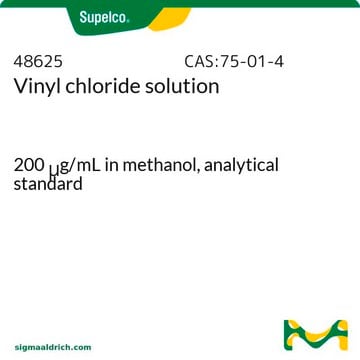All Photos(1)
About This Item
Linear Formula:
CH3(CH2)3CH3
CAS Number:
Molecular Weight:
72.15
Beilstein:
969132
EC Number:
MDL number:
UNSPSC Code:
12191502
PubChem Substance ID:
NACRES:
NA.21
Recommended Products
vapor density
2.48 (vs air)
Assay
≥99% (GC)
form
liquid
autoignition temp.
500 °F
expl. lim.
~8.3 %
refractive index
n20/D 1.358 (lit.)
bp
35-36 °C (lit.)
mp
−130 °C (lit.)
density
0.626 g/mL at 25 °C (lit.)
SMILES string
CCCCC
InChI
1S/C5H12/c1-3-5-4-2/h3-5H2,1-2H3
InChI key
OFBQJSOFQDEBGM-UHFFFAOYSA-N
Looking for similar products? Visit Product Comparison Guide
General description
Pentane (n-pentane) is a hydrocarbon. Its hydroisomerization using a nanocrystalline beta (BEA) zeolite has been proposed. It has been reported as one of the products formed from the peroxidation of unsaturated fatty acid.
Other Notes
Pertains only in Germany: unversteuert
Signal Word
Danger
Hazard Statements
Precautionary Statements
Hazard Classifications
Aquatic Chronic 2 - Asp. Tox. 1 - Flam. Liq. 2 - STOT SE 3
Target Organs
Central nervous system
Supplementary Hazards
Storage Class Code
3 - Flammable liquids
WGK
WGK 2
Flash Point(F)
-56.2 °F - closed cup
Flash Point(C)
-49.00 °C - closed cup
Choose from one of the most recent versions:
Already Own This Product?
Find documentation for the products that you have recently purchased in the Document Library.
James Clarke et al.
Nature nanotechnology, 4(4), 265-270 (2009-04-08)
A single-molecule method for sequencing DNA that does not require fluorescent labelling could reduce costs and increase sequencing speeds. An exonuclease enzyme might be used to cleave individual nucleotide molecules from the DNA, and when coupled to an appropriate detection
Michael Mayer et al.
Biophysical journal, 85(4), 2684-2695 (2003-09-26)
We present a straightforward, accessible method for the fabrication of micropores with diameters from 2 to 800 micro m in films of amorphous Teflon (Teflon AF). Pores with diameters </=40 micro m made it possible to record ion fluxes through
Our team of scientists has experience in all areas of research including Life Science, Material Science, Chemical Synthesis, Chromatography, Analytical and many others.
Contact Technical Service








